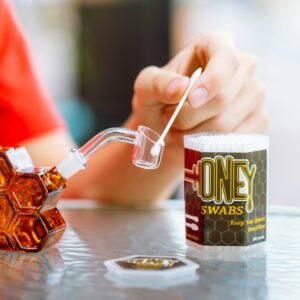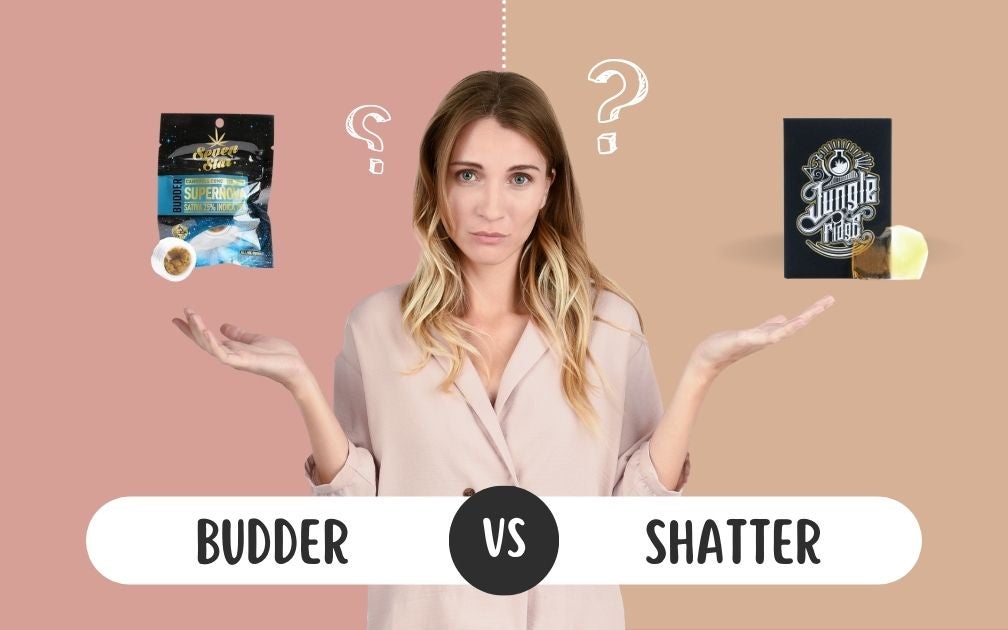Table of Contents
- Getting to Know Budder
- Getting to Know Shatter
- Comparing Budder and Shatter
- Pros and Cons of Budder and Shatter
- How to Consume Budder and Shatter
- Conclusion
- FAQs
The world of cannabis concentrates offers a plethora of options for those seeking potent and flavorful experiences. Among the various types of cannabis concentrates, budder and shatter have gained popularity among enthusiasts. In this article, we’ll delve into the differences between these two popular concentrates, their unique features, and how to choose the right one for your needs. Let’s get started!
Getting to Know Budder
What is Budder?
Budder, sometimes called wax concentrate, is a cannabis extract that boasts a buttery, creamy consistency. It is created by extracting cannabinoids and terpenes from the cannabis plant using a solvent like butane.
What is The Process of Creating Budder?
To make budder, the extraction processes involve purging the solvent from the concentrate by applying heat in a vacuum oven. The resulting substance is then whipped to achieve its smooth and spreadable texture.
What are The Characteristics of Budder?
Budder crumble has a texture that sets it apart from other types of extracts. Its soft, easy-to-handle consistency makes it a popular concentrate choice for those who prefer a more manageable product.
Getting to Know Shatter
What is Shatter?
Similarly to budder, shatter is another form of cannabis concentrate. It has a glass-like appearance and consistency, often displaying a translucent amber or golden hue.
What is The Process of Creating Shatter?
Shatter is produced by extracting cannabinoids and terpenes from the cannabis plant using a solvent, just like budder. However, shatter isn’t whipped during the purging process, allowing it to cool and harden into its signature glass-like texture.
What are the Characteristics of Shatter?
As the name suggests, shatter is brittle and can easily break, making it slightly more challenging to handle than budder. Its unique texture also enables clean and precise dosing.
Comparing Budder and Shatter
Potency
Budder and shatter are both potent cannabis concentrates, generally containing between 70% and 90% THC. The precise potency depends on the strain and extraction method used. However, both options promise a powerful and long-lasting high.
Consistency
Budder has a creamy, spreadable consistency, whereas shatter is brittle and glass-like. These differences in texture can influence personal preference and ease of use.
Flavour and Aroma
Thanks to its higher terpene content, budder tends to have a more pronounced flavour and aroma than shatter. However, shatter can still offer an enjoyable taste and smell, although it might be less intense due to the nature of its production process.
For a more detailed comparison of various cannabis concentrates, including live resin, check out this comparison of concentrates.
Pros and Cons of Budder and Shatter
Advantages of Budder
- Creamy, easy-to-handle texture
- Rich flavour and aroma due to higher terpene retention
- Versatile and easy to use with various consumption methods
Disadvantages of Budder
- Less stable and more prone to melting at higher temperatures
- Potentially shorter shelf life compared to shatter
Advantages of Shatter
- Highly stable and less likely to degrade over time
- Precise dosing due to its brittle texture
- Longer shelf life when stored properly
Disadvantages of Shatter
- More challenging to handle and work with
- Less pronounced flavour and aroma compared to budder
How to Consume Budder and Shatter
Dabbing
Both budder and shatter can be consumed using a dab rig. This method involves heating a small amount of concentrate on a heated surface, such as a nail or banger, and inhaling the vapour through a water pipe. If you’re new to dabbing, read our guide on how to smoke shatter.

Vaporizing
Vaporizing or “vaping” is another popular method for consuming cannabis concentrates. Many vaporizers on the market are compatible with both budder and shatter, making it a convenient and discreet option.

Price Difference
The price difference between budder and shatter can vary depending on factors such as quality, availability, and location. Generally, budder may be slightly more expensive due to its higher terpene content and richer flavour profile. To find the best deals on shatter, check out our guide on how to shop for shatter in Canada.
Conclusion
Ultimately, the choice between budder and shatter comes down to personal preference, as both offer a potent and enjoyable cannabis experience. If you value rich flavour and a creamy texture, budder may be your choice. On the other hand, if stability and precise dosing are more important, shatter might be the better option.
To explore a wide range of cannabis concentrate products, visit our shatter category page and budder category page. Don’t forget to read our review of concentrate products for more information on what to expect from each type of concentrate. Happy dabbing!
FAQs
Is budder or shatter better for beginners?
There’s no definitive answer, as it depends on personal preference. Some may find budder easier to handle, while others may prefer shatter’s stability and precise dosing.
Can I mix budder and shatter in the same dab?
Yes, mixing budder and shatter in a single dab can provide a unique combination of flavours and textures. Experiment with different ratios to find your ideal mix.
How do I know if my budder or shatter has gone bad?
Changes in colour, consistency, or smell can be indicators that your concentrate has degraded. Proper storage can help maintain the quality of your budder or shatter over time.
Are there other types of cannabis concentrates besides budder and shatter?
Yes, there are numerous other concentrates, such as crumble, live resin, rosin, and distillate. Each concentrate has its unique properties, textures, and extraction methods.
Can I make budder or shatter at home?
While it is possible to make concentrates at home, the process can be dangerous and complex. It’s recommended to purchase your budder or shatter from a reputable dispensary to ensure safety and quality.



